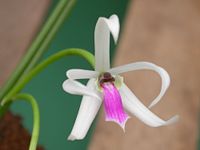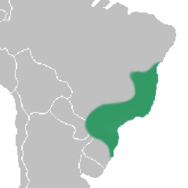Leptotes (orchid): Difference between revisions
imported>Chris Day |
imported>Dalton Holland Baptista No edit summary |
||
| Line 50: | Line 50: | ||
''Leptotes'' [[pollination]] has never been observed and the assumptions about its agents are different, [[Cássio van den Berg]] assumes that, because of the colors and morphology of its flowers, they might be pollinated by [[bee]]s,<ref name="CBGO"/> while other orchidologists indicate the possibility of [[humminbird]] pollination.<ref name="DM"/> | ''Leptotes'' [[pollination]] has never been observed and the assumptions about its agents are different, [[Cássio van den Berg]] assumes that, because of the colors and morphology of its flowers, they might be pollinated by [[bee]]s,<ref name="CBGO"/> while other orchidologists indicate the possibility of [[humminbird]] pollination.<ref name="DM"/> | ||
<!-- | |||
==Taxonomia== | |||
Em abril de 1833, floresceu na estufa da Sra. Arnold Harrison, colecionadora de orquídeas inglesa homenageada em diversas descrições de conhecidas espécies tais como ''[[Bifrenaria harrisoniae]]'' e ''[[Cattleya harrisoniana]]'' uma espécie desconhecida que recebera da [[Serra dos Órgãos]], no Brasil. Pouco tempo depois, a Sra. Harrison enviou um desenho e uma muda desta planta para o botânico [[John Lindley]], que verificou tratar-se de um novo gênero. Em sua descrição, datada do mesmo ano, | |||
Lindley propõe o nome de ''Leptotes'', do [[língua grega|grego]], ''suave'', ''delicado'', em referência à aparência das flores desta planta. Afirma que ''Leptotes'' é um gênero similar e próximo a ''[[Tetramicra]]'' do qual distingue-se pela estrutura das polínias; pelos lobos laterais do labelo de suas flores, muito menores; e por não apresentar [[calcar]] preso ao [[ovário]] e que de ''Brassavola'' diferencia-se também pelas polínias e pelo labelo trilobado. Descreve em seguida sua [[espécie-tipo]], a ''[[Leptotes bicolor]]''.<ref><span style="font-variant:small-caps;">Lindley, John</span>: ''Leptotes bicolor'' em '''Edward's Botanical Register Vol.19''', t.1625. James Ridgway & Sons Ed. London, 1833. [http://www.botanicus.org/item/31753002748314 Publicado na internet, em inglês.]</ref> | |||
Em 1838, Lindley recebeu duas plantas levemente diferentes entre si, provenientes de [[Macaé de Cima]] e da [[Ilha Grande]], no Rio de Janeiro, considerando-as diferentes da espécie previamente descrita, pois os lobos laterais do labelo eram levemente serrilhados, suas flores maiores, e apresentarem ainda uma segunda folha ocasional por pseudobulbo, propôs uma nova espécie com o nome de ''Leptotes serrulata''.<ref><span style="font-variant:small-caps;">Lindley, John</span>: ''Leptotes serrulata'' em '''Sertum orchidaceum''', t.11. James Ridgway & Sons Ed. London, 1838. [http://www.botanicus.org/item/31753002748314 Publicado na internet, em inglês.]</ref> Cinco anos mais tarde, o conde alemão [[Johann Centurius von Hoffmannsegg]], considerando que as folhas de uma planta que cultivava apresentavam um tom verde-azulado diferente, descreveu a planta denominando-a ''L. glaucophylla''.<ref><span style="font-variant:small-caps;">Hoffmannsegg, Johann Centurius von</span>: ''Leptotes glaucophylla'' em '''Botanische Zeitung Vol.1''', p. 833. Berlin, 1843.</ref> Ao rever as espécies até então conhecidas de ''Leptotes'', em 1990, [[Carl Leslie Withner]], contrariando diversos taxonomistas anteriores que já haviam notado a grande semelhança de todas as espécies até então descritas, vai ainda mais longe e, baseando-se nos desenhos publicados por Lindley, encontra diferenças adicionais entre a ''L. bicolor'' e a ''L. serrulata'', afirmando que a segunda é muito mais florífera, com até sete flores por inflorescência, a qual é muito mais longa.<ref name="W"><span style="font-variant:small-caps;">Withner, Carl Leslie</span>: '''The Cattleyas and Their Relatives, Vol. 3''', p.96. Timber Press, Oregon. ISBN 0881922692</ref> Hoje sabemos que ambas descrições são de pequenas variações da ''L. bicolor'', que, pela sua ampla dispersão e multiplicidade de populações, é planta bastante variável.<ref name="K"><span style="font-variant:small-caps;">Govaerts, Rafaël ''et al''</span>: '''World Checklist of Orchidaceae'''. The Board of Trustees of the Royal Botanic Gardens, Kew. {{link|en|2=http://www.kew.org/wcsp|3=Publicado na Internet}} (consultada em janeiro de 2009).</ref> | |||
Em 1865, [[Heinrich Gustav Reichenbach]], recebeu, de local desconhecido do Brasil, a segunda espécie hoje aceita a ser descrita, uma planta muito diferente da ''Leptotes bicolor'', por ter folhas curtas e aglomeradas, e poucas flores pequenas e mais arredondadas, de segmentos amarelados bem explanados, publicou-a com o nome de ''L. tenuis''.<ref><span style="font-variant:small-caps;">Reichenbach, Heinrich Gustav</span>: ''Leptotes tenuis'' em '''Hamburger Garten Blumenzeitung Vol.21''', pp. 296. Hamburg, 1865.</ref> Doze anos mais tarde, a terceira espécie, a ''Leptotes unicolor'' foi descrita pelo botânico brasileiro [[João Barbosa Rodrigues]]. Segundo o autor, tratava-se de espécie muito perfumada e pequena, da qual encontrara mais de uma centena de exemplares vivendo epífitas às margens dos rios [[Rio Dourado|Dourado]], [[Rio das Antas|das Antas]] e [[Rio Sapucai|Sapucai]], perto da cidade mineira de [[Alfenas]].<ref><span style="font-variant:small-caps;">Barbosa Rodrigues, João</span>: ''Leptotes unicolor'' em '''Genera et species orchidacearum novarum''' Vol.1, p.74. 1877. [http://www.botanicus.org/title/b12207019 Publicado na Internet, em francês e latim.]</ref> Em 1881, Barbosa Rodrigues encontrou uma outra planta com folhas mais longas e pequenas diferenças na estrutura da flor, em [[Joinville]], na época situada no [[Paraná]] pois o [[Estado de Santa Catarina]] ainda não havia sido criado, e descreveu-a com o nome de ''L. paranaensis''.<ref><span style="font-variant:small-caps;">Barbosa Rodrigues, João</span>: ''Leptotes paranaensis'' em '''Genera et species orchidacearum novarum''' Vol.2, pp.163. 1881. [http://www.botanicus.org/title/b12207019 Publicado na Internet, em francês e latim.]</ref> Atualmente é considerada uma variação da ''L. unicolor'' já descrita por ele quatro anos antes.<ref name="OB"><span style="font-variant:small-caps">Pabst, Guido & Dungs, Fritz </span>: '''Orchidaceae Brasilienses vol. 1''' p. 148, Brucke-Verlag Kurt Schmersow, Hildesheim, 1975. ISBN 3871050106 </ref> | |||
Oito anos mais tarde, [[Robert Allen Rolfe]] recebeu, também de localidade ignorada do Brasil, uma planta similar à ''Leptotes tenuis'' que Reichenbach descrevera em 1865, porém com folhas bem mais grossas e curtas, descreveu-a com o nome de ''L. minuta''.<ref><span style="font-variant:small-caps;">Rolfe, Robert Allen</span>: ''Leptotes minuta'' em '''Gardeners' Chronicle Vol.1889-2''': p. 323. London, 1889.</ref> Em sua revisão das plantas do Brasil, publicada em 1903, [[Célestin Alfred Cogniaux]], ignorando a variabilidade a que estavam sujeitas as espécies de ''Leptotes'', tanto pela existência de diversas populações isoladas, bem como por diferenças no comprimento e espessura das folhas devido a variações decorrentes de maior ou menor exposição à luz, aceitou como boa esta espécie que sabe-se ser uma variação da ''L. tenuis'', bem como a maioria das outras até então descritas.<ref><span style="font-variant:small-caps;">Cogniaux, Célestin Alfred</span>: ''Leptotes'' em '''Flora Brasiliensis Vol.3 Part.6''': pp. 254-259. K.F.P. von Martius Ed., 1903. [http://florabrasiliensis.cria.org.br/search?taxon_id=1511 Publicado na Internet, em latim.]</ref> | |||
Johan Albert Constantin Loefgren, botânico sueco radicado no Brasil, recebeu de [[Itatiaia]], no Rio de Janeiro, em 1918, uma orquídea cujas flores recordavam as de ''Leptotes'' porém com labelo saquiforme, com folhas planas e delgadas, e hábito longamente pendente. Descreveu-a como ''Leptotes blanche-amesiae''.<ref><span style="font-variant:small-caps;">Loefgren, Johan Albert Constantin</span>: ''Leptotes blanche-amesiae'' em '''Arquivos do Jardim Botânico do Rio de Janeiro Vol.2''': p. 58. Rio de Janeiro, 1918.</ref> Anos mais tarde [[Frederico Carlos Hoehne]] concluiu que esta espécie, apesar de certamente relacionada às ''Leptotes'' ficaria melhor classificada em outro gênero, assim, em homenagem a Loefgren, propôs o gênero ''[[Loefgrenianthus]]'' para acomodá-la.<ref><span style="font-variant:small-caps;">Hoehne, Frederico Carlos</span>: ''Loefgrenianthus'' em '''Arquivos de Botânica do Estado de São Paulo Vol.1''': p. 593. São Paulo, Julho de 1927.</ref> Hoehne também descreveu uma nova espécie, a ''Leptotes pauloensis'', por ter sido encontrada no [[Estado de São Paulo]] em 1934. Esta espécie lembra muito a ''Leptotes tenuis'' porem suas flores são de cores diferentes. Por muitos anos esta espécie esteve sujeita a controvérsias quanto à sua aceitação. [[Guido Frederico João Pabst|Guido Pabst]] considerava-a um sinônimo da última;<ref name="OB"/> em 1990, Withner afirmou que depois de estar desaparecida por muitos anos, finalmente esclareceram-se as dúvidas quanto a sua aceitação pois muitas haviam sido encontradas há pouco e realmente deveria ser aceita como espécie autônoma.<ref name="W"/> | |||
Portanto eram conhecidas quatro espécies de ''Leptotes'' em 2004, três bastante diferentes entre si, ''L. bicolor'', ''L. unicolor'' e ''L. tenuis'', e uma quarta, ''L. pauloensis'', ocasionalmente considerada sinônimo da anterior, mas mais frequentemente aceita pelos taxonomistas. Neste ano, o número de espécies dobrou pois outras quatro foram descritas. Mas a história destas descrições começa muito antes, em 1954, quando um dos associados do [[Círculo Paulista de Orquidófilos]], apresentou uma palestra em que discorria longa e informalmente sobre as inúmeras variedades de ''Leptotes'' que encontrara e reunira ao longo dos anos e os nomes que a elas atribuía. Esta palestra foi impressa e distribuída no boletim da associação.<ref><span style="font-variant:small-caps;">Krackowizer, F. J.</span>: ''Monografia do gênero Leptotes'' em '''Revista do Círculo Paulista de Orquidófilos Vol.11''', pp. 53-63 e 64-72. São Paulo, 1954.</ref> Em 2004, [[Eric A. Christenson]], conhecedor desta publicação, encontrou em cultivo em coleções particulares nos [[Estados Unidos]] duas das variedades mencionadas na palestra e decidiu descrevê-las formalmente como espécies autônomas. Uma dessas plantas, a ''Leptotes harryphillipsii'', é similar à ''L. pauloensis'' espécie já problemática.<ref name="EC"><span style="font-variant:small-caps;">Christenson, Eric A.</span>: ''Leptotes harryphillipsii'' em '''Orchids South Africa Vol.35''', pp. 53. Cape Town, 2004.</ref> A outra, ''L. mogyensis'', é uma espécie desconhecida dos orquidólogos e orquidófilos brasileiros a não ser pela planta apresentada por Christenson, supostamente originária de [[Mogi das Cruzes]], em São Paulo.<ref><span style="font-variant:small-caps;">Christenson, Eric A.</span>: ''Leptotes mogyensis'' em '''Orchids South Africa Vol.35''', pp. 54. Cape Town, 2004.</ref> | |||
As outras duas espécies descritas em 2004 pertencem à afinidade da ''Leptotes bicolor'' e foram ambas encontradas pelo mesmo explorador na região de [[Buerarema]], sul da [[Bahia]]. A ''Leptotes bohnkiana'', cujo nome é uma homenagem a seu descobridor, diferencia-se pelo tamanho menor,<ref><span style="font-variant:small-caps;">Campacci, Marcos Antonio</span>: ''Leptotes bohnkiana'' em Boletim CAOB Vol.53, p.17. São Paulo, 2004. ISSN 14194590.</ref> a outra, ''L. pohlitinocoi'', principalmente pela cor.<ref><span style="font-variant:small-caps;">Vitorino P. Castro Neto & Chiron, Guy</span>: ''Leptotes pohlitinocoi'' em '''Richardiana Vol.4''': p.78. Paris, 2004.</ref> Finalmente, em 2006 foi descoberta por [[Sidney Marçal de Oliveira]] a última espécie a ser descrita, também da Bahia, porém habitante da [[Chapada Diamantina]], a ''Leptotes vellozicola'' é bastante diferente de todas as outras já descritas.<ref name="CVB"><span style="font-variant:small-caps;">Van den Berg, Cássio ''et al''</span>: ''Leptotes vellozicola'' em '''Neodiversity Vol.1''', pp. 2, 2006. [http://www.neodiversity.org/articles/neod1101.pdf Publicado na Internet, em inglês.]</ref> | |||
==Filogenia== | |||
Segundo a [[filogenia]] de [[Laeliinae]] publicada no ano 2000 em ''Lindleyana'' por [[Cássio van den Berg]] et al., ''Leptotes'' é muito próximo de ''[[Loefgrenianthus]]'' e ambos situam-se entre ''[[Pseudolaelia]]'' e ''[[Schomburgkia]]''. | |||
==Espécies== | |||
==Cultivo== | |||
Por suas raízes apodrecerem com facilidade se expostas à [[umidade]] excessiva, as ''Leptotes'' são melhor cultivadas penduradas em placas de fibras vegetais ou de cascas de árvores. Não dever receber [[luz]] solar direta, as regas e [[adubação]] devem ser mais frequentes durante o período de [[crescimento]] ativo e a [[temperatura]] intermediária.<ref><span style="font-variant:small-caps;">Pridgeon, Alex</span>: ''Leptotes'' em '''Genera Orchidacearum Vol.4''', p. 274. Oxford Unity Press, 2006. ISBN 9780198507123.</ref> | |||
=={{Ver também}}== | |||
*[[Lista de gêneros de Orchidaceae]] | |||
==Referências== | |||
{{reflist|2}} | |||
=={{Links externos}}== | |||
* {{((en))}} [http://www.mobot.org/MOBOT/Research/APweb/orders/asparagalesweb.htm#Orchidaceae Angiosperm Phylogeny Website] | |||
* {{((en))}} [http://www.ars-grin.gov/cgi-bin/npgs/html/family.pl?798 GRIN Taxonomy of Plants] | |||
* {{((en))}} [http://plants.usda.gov/java/ClassificationServlet?source=display&classid=Orchidaceae USDA] | |||
--> | |||
==References== | ==References== | ||
{{reflist|2}} | {{reflist|2}} | ||
Revision as of 21:11, 18 February 2009
| Leptotes | ||||||||||||||||||||
|---|---|---|---|---|---|---|---|---|---|---|---|---|---|---|---|---|---|---|---|---|
 Leptotes bicolor
| ||||||||||||||||||||
| Scientific classification | ||||||||||||||||||||
| ||||||||||||||||||||
| Type species | ||||||||||||||||||||
| Leptotes bicolor Lindl. 1833 | ||||||||||||||||||||
| Species | ||||||||||||||||||||
| ||||||||||||||||||||
| Synonym | ||||||||||||||||||||
|
None |
Leptotes is a genus of orchids formed by nine small species of Brazil which exist in the dry jungles of South and Southeast, and also in Paraguay or Argentina. They are small epiphytic plants of caespitific growth, that sometimes resemble little Brassavola, as they share same type of thin terete leaves, however, they are more closely related to Loefgrenianthus.
Some species of Leptotes are widely cultivaded and form showy displays when completely in bloom, yet the majority of species are not commonly found under cultivation, some are rare or even almost completely unknown. Five species have only been described after year 2000. They are not included among the orchids easiest to grow. Beside being cultivated for their ornamental value, there are records of eventual uses of the flowers and fruits of Leptotes bicolor as milk, ice cream, tea and candies aromatizers instead of Vanilla.[1]
Distribution
The species of Leptotes are originary from Atlantic Forest of Brazil, two species also found in other countries, L. unicolor in Argentina, and L. bicolor in Paraguay, always living epiphyticaly. Three species show high degree of endemism in the South of Bahia State, these do not exist in any other places. The distribution of one species is only an assumption. The states southeastern of Brazil are the ones that present the highest level of species occurrence, however, the extreme limits of distribution range from the Serra da Jibóia chain of mountains, in Bahia, to the North of Rio Grande do Sul State.[2]
The species of the group of wide open flowers, as Leptotes tenuis and L. pauloensis, are more frequent in cloud mountain forests. L. bicolor is the species most spread out and adaptated both to cloud mountanin forests and to the dryer woods of plateaus above of Serra do Mar chain of Mountains. Leptotes unicolor is a plant from coller areas, above 700 meters of altitude, frequently found growing on Araucaria and Podocarpus trees in the Southern areas of Brazil.[2]
Description
The species assigned to the genus Leptotes are plants of short rhizome, of cylindrical section, with very small pseudobulbs that almost imperceptibly prolongate in one, rarely two, short or long, erect or hanging, terete fleishy leaves, of dark green or purple colors, frequently presenting wrinkly surfaces, with a more or less deeper ridge in the face. The inflorescence is apical, generally short, and grows from the apex of the pseudobulb, without a protecting spathe, bearing one to seven flowers, however two or three are more common. The flowers are relatively large when are compared to the plant dimensions, normally partially bent, in some species forming groups of very showy aspect.[2]
Their flowers generally are of different shades of pink, greenish or white, with lip spotted of pale yellow, light purple or lilac, perfumed, which last from ten to twenty days.[3] The petals and sepals are similar, elongated, of the same color, the petals slightly narrower than the sepals. The lip is located along the column, trilobated, with small lateral lobes, raised aside of the column, however never involving it, or flat; the intermediate lobe is much bigger than the lateral ones, showing lanceolated or obovated format, occasionally fleishy, flat or bending backwards; in some species with denticulated edges, in other with smooth ones; rarely calli are present and it has claws wich hold it attached to the sides of the column. This is short, thick and erect, normally greenish, biauriculated, and bears six pollinia of different sizes, two larger in the center and four smaller in two pairs hold by a short caudicle, in an arrangement without similar among the orchids. Their fruits are rounded, succulent and perfumed as the ones of Vanilla.[4]
Leptotes pollination has never been observed and the assumptions about its agents are different, Cássio van den Berg assumes that, because of the colors and morphology of its flowers, they might be pollinated by bees,[2] while other orchidologists indicate the possibility of humminbird pollination.[3]
References
- ↑ Lawler, L.J.: Ethnobotany of the Orchidaceae in Orchid biology: reviews and perspectives, Vol.3. J. Arditti Ed., Cornell University Press, Ithaca, New York, 1984.
- ↑ 2.0 2.1 2.2 2.3 Van den Berg, Cássio: Leptotes in Genera Orchidacearum Vol.4, pp. 271-3. Oxford University Press, 2006. ISBN 9780198507123.
- ↑ 3.0 3.1 Miller, David; Richard Warren; Izabel Moura Miller & Helmut Seehawer: Serra dos Órgãos sua história e suas orquídeas, p. 240. Rio de Janeiro, 2006.
- ↑ Withner, Carl Leslie: The Cattleyas and Their Relatives, Vol. 3, pp.94-95. Timber Press, Oregon. ISBN 0881922692

